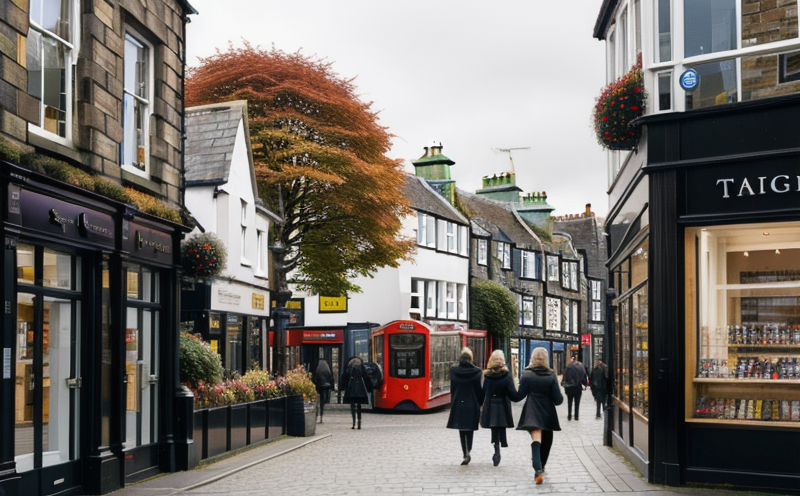Extensive Travel Disruption Looms for Perth and Kinross: Crucial Updates for the Weeks Ahead

Residents and commuters across Perth and Kinross face a period of significant travel disruption over the next two weeks, beginning October 13 and October 19, 2025. Major routes will see extensive roadworks, with several key thoroughfares experiencing full closures or convoy systems. Bus services will be altered, and train passengers travelling to and from Perth will need to plan for replacement services. Local authorities and transport operators are advising individuals to check their routes well in advance and allow extra time for journeys. Roadworks and Closures Impacting Perth and Kinross One of the most notable disruptions for Perthshire locals will be the prolonged closure of the A827 between Aberfeldy and Kenmore in Highland Perthshire. This vital artery is scheduled for weekday closures from October 13 to October 26 as teams work to rebuild a section of a retaining wall. Drivers are being advised to follow an official diversion route stretching approximately 70 miles, significantly impacting travel times for those traversing the scenic region. Further south, the A9, a primary north-south route, will also experience overnight resurfacing operations. North of Inveralmond, works are scheduled from October 7 to October 15, between 7pm and 6am. This will involve a 10mph convoy system and temporary traffic lights. Similarly, at Luncarty, overnight resurfacing will take place from October 14 to October 28, also between 7pm and 6am, utilizing temporary traffic lights and a convoy. Critically, the on and off-slip roads at Luncarty will be closed during these overnight hours, though traffic management will be lifted for weekends, providing some respite. The A90, connecting Perth to Dundee, continues to be a site of ongoing road safety improvements. From the Rait junction to Middlebank Farm centre, lane two will remain closed, with a 30mph speed limit enforced. An overnight convoy system will also operate in lane one between 9pm and 5am with reduced speed limits, continuing until October 31. This persistent activity on a key dual carriageway is expected to cause delays, particularly during early morning and late evening commutes. Several smaller, more localised road closures are also planned across Perth and Kinross: – **A911 (Scotlandwell):** A section of Leslie Road will be closed from October 1 to October 15. – **B8033 (Braco):** This road will be fully closed with parking restrictions from October 20 to October 31. – **B8062 (Dunning):** Expect closures and parking restrictions from October 13 to October 17. – **B934 (Dunning):** A specific closure with parking restrictions is set for October 14. – **B948 (Coupar Angus):** Athole Street, Causewayend, and George Square will be closed from October 22 to October 31. – **Station Road (Invergowrie):** This route will see closures and parking restrictions from October 20 to October 31. Regional Road Updates Affecting Perth Travellers Beyond Perth and Kinross, commuters travelling through neighbouring regions will encounter further disruptions. In Dundee, the A90 Kingsway will operate an overnight convoy system between the A923 Coupar Angus off-slip and Strathmartine Road from October 5 to October 27. Northbound slip roads at the A923, Macalpine Road, and Strathmartine Road will also be closed overnight from Sunday to Thursday between 7:30pm and 6:30am. Other Dundee closures include Blackness Road (Oct 13-15), Craigie Avenue (until Oct 26), Kings Cross Road (Oct 22-23), Law Road (Oct 13-Dec 12), and Pirkerro Road (Oct 20-23). Angus roads will see the A937 near Hillside closed overnight (Oct 25-26) for Network Rail works. Resurfacing continues on the A933 at Colliston (Sep 22-TBC), and footway resurfacing on the A92 North Esk Road in Montrose (Sep 29-Oct 24). Further closures are scheduled for the B9127 Arbirlot Road West in Arbroath (Oct 23) and the B9128 North Street in Forfar (Sep 22-Oct 24). In Fife, the M90 near Dunfermline will have overnight slip road closures at Junction 1C Admirality and Junction 2 Pitreavie from 8pm to 6am on weekdays until October 17. The A91 Low Road in Auchtermuchty will be closed between Crosshills and Carswell Wynd from 9am on October 19 to 6am on October 21 for Scottish Water works. Other closures include B917 Black Road in Kelty (Sep 29-Feb 27, 2026), B939 Argyle Street in St Andrews (Oct 13-15), B945 William Street in Tayport (Oct 13-17), and Fair Isle Road in Kirkcaldy (Oct 13-17), along with Glenwood Road in Leslie (Sep 22-TBC). Stirling and Stirlingshire also have their share of roadworks. The A9 Causewayhead Road in Stirling will be closed from the Customs Roundabout to Cornton Road on October 19 (9:30am-4:30pm). The M80 near Denny will see southbound carriageway closures at Junction 9 Pirnhall (Oct 13-14) for defect repairs, while near Haggs, the northbound carriageway will be closed between Junction 7 and Junction 8 (Oct 20-22) for resurfacing. Further up, the A82 at Glen Falloch near Inverarnan has a lane closure, temporary traffic lights, and a 30mph speed limit until October 21 for bridge parapet and safety barrier replacement. Additionally, three-way temporary traffic lights are in operation on the A84 at Stirling Dobbies until October 16 for a new pedestrian crossing, and the B8032 at Deanston will experience closures and parking restrictions (Oct 13-19 and Oct 20). Forthside Way in Stirling will be closed from September 22 to December 5 for active travel route construction. Bus Service Alterations Bus travellers in areas connected to Perth and Kinross should be aware of several diversions. Stagecoach services 73, 73A, 73B, and 73C heading northbound along Craigie Avenue in Dundee will be diverted onto Greendykes Road and Arbroath Road until November 1, bypassing regular stops along the diversion route. Xplore Dundee’s 5A service, when heading towards Ninewells Hospital, will be diverted between Greendykes Circle and Eastern Cemetery until October 26, with alternative stops available near Balgavies Avenue and Dalgleish Road. In Fife, Stagecoach services 42 and 42A face changes due to the William Street closure in Tayport from October 13 to October 17. The 42 service from Glenrothes to Dundee will not serve Tayport between 9am and 4pm, while the 42A from St Andrews to Dundee will terminate at Shanwell Turning Circle during these hours. Other Fife
Extended 70-Mile Diversion Implemented in Highland Perthshire for Critical Road Repairs

Highland Perthshire is bracing for significant travel disruption as a key artery, the A827 between the popular communities of Aberfeldy and Kenmore, is set for a substantial two-week closure. Starting October 13, and running exclusively Monday through Friday, these critical infrastructure works will divert traffic on a lengthy 70-mile route, making careful journey planning absolutely essential for everyone in the region. The necessity for this closure stems from urgent structural defects identified in a gabion retaining wall located at Bolfracks. To clarify for our local audience, a gabion wall is a robust engineering solution, essentially large wire mesh cages meticulously filled with stones. These are strategically employed to provide crucial support to embankments, prevent soil erosion, and secure landscapes, particularly vital in the undulating and sometimes challenging topography characteristic of Highland Perthshire. The integrity of such a structure is paramount to road safety, and its failure could have severe consequences. Therefore, this comprehensive rebuilding project is not merely a maintenance task but an indispensable undertaking to guarantee the long-term stability and safety of this much-used road segment. Perth and Kinross Council has conveyed the profound importance of these repairs, emphasizing a commitment to complete them fully within the current year. This proactive approach aims to avert any future recurrence of similar structural issues and to avoid further prolonged disruptions to the community. The initial two-week phase will involve intensive, full-scale reconstruction of the compromised gabion section, requiring the complete cessation of traffic flow. Following this intensive period, a subsequent phase will commence from October 27, lasting one week. During this time, traffic will transition to a single-lane operation, carefully controlled by temporary traffic lights, allowing for the meticulous finishing work and ensuring the newly constructed wall has adequate time to settle securely. The officially mandated diversion route is extensive, covering approximately 70 miles, a journey that will add considerable time to commutes and travel plans. For those heading in an eastward direction, the prescribed itinerary involves proceeding along the A827 until Lix Toll. From there, traffic will merge onto the A85, continuing towards Gilmerton. The route then necessitates a transition via the A822 and subsequently the A826, ultimately guiding motorists back to Aberfeldy. Conversely, all westbound traffic will be instructed to follow this detailed route in the precise reverse order. This substantial detour underscores the unique geographical layout of this part of Perth and Kinross, where direct, convenient alternative routes are simply non-existent. Consequently, these planned closures present a considerable challenge, impacting daily lives and local economies profoundly. A spokesperson from Perth and Kinross Council openly acknowledged the profound impact of these measures. “We understand and apologise for the additional inconvenience to local residents, businesses and visitors to the area,” the spokesperson stated, expressing genuine regret for the inevitable disruption. However, the official firmly reiterated the strategic necessity: “these changes are required to ensure this vital work can be completed this year and without having to reopen the site again next year along with the additional road restrictions this would require. We appreciate your understanding.” This unequivocal statement reflects the local authority’s steadfast dedication to public safety, the resilience of regional infrastructure, and a proactive stance on maintenance, even when it demands temporary concessions from the valued communities of Highland Perthshire. The ripple effect of such a significant road closure extends far beyond just an increase in driving time. Local enterprises in charming towns like Aberfeldy and Kenmore, which thrive on the steady flow of tourism and local patronage—including many day-trippers from Perth itself—could foreseeably experience a downturn in trade. The logistical challenges for delivery services and essential support providers catering to residents within the affected corridor will also be substantial, requiring meticulous re-routing and additional operational time. Furthermore, the agricultural sector, a cornerstone of the Highland Perthshire economy, which relies heavily on efficient transportation for farm produce, equipment, and livestock, will undoubtedly need to implement significant adjustments to their daily operations. Given these impending changes, residents and anyone intending to travel through the area are strongly advised to undertake thorough journey planning. This includes allocating considerable additional travel time, especially for time-sensitive appointments, school runs, or urgent commitments. While the diversion adds substantial mileage, it stands as the singular safe and officially endorsed alternative, meticulously designed to ensure that all road users can safely bypass the extensive works zone. This forthcoming period of temporary disruption, though undeniably challenging, is presented as a fundamental and critical investment in the enduring reliability, resilience, and safety of Highland Perthshire’s vital road network. This, in turn, promises lasting benefits for all individuals who proudly call this beautiful part of Scotland home, as well as those who visit its stunning landscapes and vibrant communities. Perth and Kinross Council will continue to provide regular updates regarding the ongoing progress of these essential works and any potential modifications to the established schedule. It is highly recommended that anyone planning to traverse this route during the specified closure and restriction periods should diligently monitor local traffic reports and official council advisories to remain fully informed and minimize unforeseen inconveniences.
A Century of Compassion: Blairgowrie Family Funeral Directors Mark 100 Years of Service in Perth and Kinross

A remarkable milestone is being celebrated in Blairgowrie as David Scott (Blairgowrie Ltd) marks a full century of dedicated service to families across Perth and Kinross. The cherished local funeral directors, currently led by 36-year-old Martin Mackay, continues a profound family legacy that began in 1925. The roots of this esteemed establishment stretch back to David Scott Senior, Martin’s great-grandfather, who launched his venture with a mere five pounds and a toolkit borrowed from his brother, John. Initially, the business seamlessly integrated both joinery and undertaking services—a common practice in that era—laying the groundwork for a tradition of meticulous care. Through the decades, the firm evolved under the stewardship of Martin’s grandfather, also named David Scott. By the early 1990s, David’s son-in-law, Billy Mackay, had joined the ranks, eventually guiding the company to focus exclusively on funeral services following the sale of the joinery division. This pivotal shift saw the business rebranded as David Scott (Blairgowrie Ltd) Funeral Directors, maintaining its trusted presence in the community. Growing up in Blairgowrie, Martin initially envisioned a different career path, aspiring to become a teacher. He even secured a place at Edinburgh University to pursue primary education. However, a summer job assisting his father at the funeral home proved to be a transformative experience. “Dad needed someone to help wash the cars,” Martin recollects, describing his initial tasks. This soon expanded to include on-call duties, and by the age of 19, he realised his true calling lay within the family business. Choosing to forgo university, he immersed himself in the trade, learning from seasoned professionals like Fergie Alexander and Dave Findlay, the latter having even worked with his great-grandfather. After more than fifteen years, Martin’s profound respect for the role has only deepened. He emphasises that the most rewarding aspect is the deep trust local residents place in him and his team. “People turn to you during their most vulnerable moments,” he explains, highlighting the importance of guiding them through their grief with unwavering support. This sentiment is particularly strong in close-knit communities such as Blairgowrie and Alyth, where personal connections form the bedrock of their service. Beyond the dignified world of funeral directing, the Mackay family boasts a rich and varied heritage. Martin’s father, Billy, once graced the football pitches under the bright lights of Ibrox, playing for Rangers and later Hearts in the late 1970s and early 1980s. A notable moment in his career included being on the pitch at Dens Park when Albert Kidd’s two goals for Dundee famously snatched the league title from Hearts in 1986. Billy, a modest figure, later channelled his passion into local football, managing Blairgowrie Juniors, an esteemed local club where Martin’s grandfather served as president for decades. Martin himself contributed as club secretary before the global pandemic. Funeral practices have undergone considerable transformation over the past century. Where once coffins were handcrafted in a local joinery workshop and services were straightforward local affairs, today’s expectations have diversified significantly. “There’s no such thing as a ‘typical’ funeral anymore,” Martin observes. Modern technology now enables live streaming of services, connecting grieving families with loved ones across continents, from Australia to Canada. This technological integration has become an invaluable tool for maintaining family bonds during difficult times. The shift towards personalisation means families are more actively involved in tailoring services to reflect the unique life and passions of their loved ones. From live music to personal eulogies and even eco-friendly options like natural burials in private gardens, the firm strives to accommodate diverse wishes. “We rarely say we can’t do that,” Martin assures, underscoring their commitment to fulfilling every family’s request with dignity. Working alongside his parents, Billy and Margot, and with his wife Susan managing pre-paid plans, Martin acknowledges the unique dynamics of a family business. He admits the initial years, while living at home and all involved in the local football club, presented a few challenges. However, he notes, “now we’re truly partners.” His own commitment to professional development was recently recognised when he became the first person in Scotland to achieve a Diploma in Funeral Directing from the IFD College in 2024. Looking ahead, Martin is optimistic about the future, anticipating continued evolution with a growing emphasis on eco-friendly funeral options. Yet, the core philosophy remains unchanged: an unwavering dedication to caring for people during their most profound moments of loss, ensuring the David Scott legacy of compassionate service endures for generations to come.
Perth Care Worker Jailed in Historic Abuse Case Amidst Latest Tayside and Fife Court Rulings

The judicial proceedings across Tayside and Fife recently concluded with several notable sentences, including the imprisonment of a former care worker from Perth convicted of historical child sexual abuse, and penalties issued to individuals involved in assaults and driving offences. In a case that sent ripples through the Perth community, 70-year-old Peter Murray, formerly residing in Almondvale Court, Livingston, was handed a ten-year prison sentence. His conviction followed a trial at the High Court in Edinburgh where a jury found him guilty of two charges of indecent assault. The deeply disturbing crimes took place decades ago at the Colonsay Children’s Home in Perth, a facility intended to safeguard vulnerable youngsters. Murray was found to have sexually assaulted a boy and a girl, both aged 14 at the time, between 1976 and 1981. The court heard harrowing details from one of his victims, who courageously came forward to detectives in England in 2022 to expose the “terrible” and “disgusting” abuse. She revealed how Murray would offer her money for sexual favours, telling her, “what would you do for more pocket money. You could do me favours. I could make sure you could get more pocket money.” Despite Murray’s consistent denial of the charges throughout his trial, the evidence presented led to his conviction. Defence counsel highlighted his subsequent “pro-social life” and steady employment, along with current medical issues, but these factors did not diminish the gravity of his past actions. Murray, who attended his sentencing from prison via video link, has also been placed indefinitely on the sex offenders register, a measure to protect future vulnerable individuals. The outcome underscores the justice system’s commitment to holding perpetrators accountable, regardless of the passage of time, and the vital importance of victims finding the strength to report abuse. Dundee Woman Sentenced for Violent Robbery in City Multi Dundee Sheriff Court recently handled the case of Caroline Montieth, a 38-year-old repeat offender originally from Aberdeen, who was sentenced for a violent robbery in a Dundee residential tower block. Montieth admitted to attacking her male victim on September 8 at Hilltown Court, biting him on the head and kicking him repeatedly, before stealing his money. This assault occurred while she was out on bail for three separate offences from Aberdeen Sheriff Court, highlighting a concerning pattern of behaviour. Given her history of violent convictions, Sheriff Allan Findlay ordered Montieth to pay £300 in compensation to her victim. Tragic Road Fatality in Broughty Ferry Leads to Conviction In another significant case, Gordon Telford, a pickup truck driver, entered a guilty plea at court for causing the death of 93-year-old Sheila Nicoll in a devastating road traffic collision. The tragic incident occurred in Broughty Ferry when Ms. Nicoll was struck while crossing the road, resulting in her hitting her head on a kerb. This unfortunate event serves as a stark reminder of the critical importance of road safety and vigilance for all road users in the Tayside region. Fife Sex Offender Jailed for Breaching Chatroom Ban From Fife, Martin Lindores, a convicted sex offender, found himself back behind bars after violating the conditions of his community payback order. Lindores was explicitly prohibited from using online chatrooms without official consent. However, he was discovered engaging in multiplayer games on his Xbox, where he communicated indecent messages to individuals he believed to be children. This breach highlights the stringent nature of orders placed on sex offenders and the persistent risks posed by online platforms if not properly monitored. His imprisonment reflects the judiciary’s firm stance on enforcing protective measures against such individuals within the Fife community. Dunfermline Man’s Driving Ban Before Relocation In Kirkcaldy Sheriff Court, John Donald, a resident of Dunfermline, faced charges of drug-driving. The former Edinburgh Airport baggage handler was apprehended on the morning of December 30 last year. Police observed Donald while he was driving home to Fieldfare View after dropping his partner at work. A roadside drug test proved positive, leading to his arrest. Subsequent blood tests confirmed the presence of excess Delta-9-THC, the primary psychoactive component of cannabis, in his system. Donald, a first-time offender, informed the court of his plans to move to Thailand by the end of the year. His defence solicitor noted that Donald is a regular user of cannabis and admitted to consuming a significant amount the evening before his arrest. Sheriff Steven Borthwick KC issued a one-year driving disqualification and imposed a total fine of £420, ensuring Donald will not be legally permitted to drive in Scotland before his planned emigration to Southeast Asia. This case underscores the ongoing efforts by law enforcement in Fife to tackle drug-driving and maintain road safety for all citizens. ” , “positive_prompt”: “A powerful image depicting the concept of justice being served, with a balanced scale in the foreground. In the background, subtly visible are elements suggesting a diverse community and an urban skyline (like Dundee or Perth). The mood is solemn and authoritative, but also conveys a sense of resolution and protection. Photo-realistic, with strong chiaroscuro lighting.
Perth High Street Sees Departure as Cancer Research UK Announces Scott Street Shop Closure

A familiar presence on Perth’s bustling Scott Street is set to vanish, as Cancer Research UK has confirmed plans to close its local retail outlet. The decision, part of a wider strategic overhaul impacting numerous stores across the United Kingdom, means the Perth shop will cease trading by May 2026. This news comes amidst a challenging period for high street retailers, with the charity sector also feeling the pinch of shifting consumer habits and economic pressures. Cancer Research UK cited a combination of rising operational costs, inflationary pressures, a noticeable decline in footfall in traditional shopping areas, increased National Insurance contributions, and intensified competition from burgeoning online resale platforms as primary drivers behind the restructuring. The Perth store is one of 89 locations nationwide slated for closure by May 2026, with an additional 100 shops expected to follow suit by April 2027. This significant reduction in physical retail presence is intended to streamline operations and ensure the charity can maximise its financial contribution to vital cancer research initiatives. Other Scottish cities, including Aberdeen, Edinburgh, Falkirk, and Glasgow, will also see some of their Cancer Research UK branches close as part of this national strategy. In response to the evolving retail landscape, the charity intends to retain a portfolio of 320 high-performing shops across the UK. Furthermore, there are plans to inaugurate 12 new, larger out-of-town superstores over the next two years, indicating a strategic pivot towards different retail models that may offer better efficiency and reach. The charity is also preparing to close its dedicated online marketplace in early 2026, suggesting a comprehensive re-evaluation of its entire retail footprint. Michelle Mitchell, Chief Executive of Cancer Research UK, underscored the necessity of these difficult choices. She stated, “Without action, we predict many of our shops will become unprofitable. A smaller, high-performing retail operation will mean we will fund more life-saving cancer research and better serve our customers, staff and volunteers.” Her statement continued, acknowledging the human element: “This news will be difficult. Our decisions have been taken after serious consideration. We’re committed to supporting everyone affected by these changes, and will provide clear information and support throughout the process.” This commitment extends to the dedicated staff and volunteers who have been the backbone of the Perth store, serving the local community with their time and effort. The closure of the Perth branch is projected to contribute positively to the charity’s core mission, with an anticipated increase of approximately £12.4 million in financial contribution to research over the next five years. This strategic redirection aims to ensure that every penny raised works harder towards finding cures and improving treatments for cancer. For Perth, this announcement adds to a growing list of changes on the high street. Earlier reports highlighted the closure of the British Heart Foundation’s home store in the city, underscoring a broader trend of retail shifts affecting charity organisations and the overall vibrancy of Perth’s city centre. Local residents and shoppers, who have long supported the Cancer Research UK shop through donations and purchases, may feel the loss of another community-focused establishment. The ongoing evolution of retail in Perth presents both challenges and opportunities for local businesses and community groups to adapt and innovate. The continued presence of charity shops like Cancer Research UK has always been important to the fabric of Perth’s community, offering affordable goods, volunteer opportunities, and a tangible connection to vital causes. As the charity navigates these changes, the focus remains firmly on its ultimate goal: accelerating life-saving research that benefits individuals and families affected by cancer, not just in Perth and Kinross, but across the nation and beyond.
Contractor Airlifted from Crieff Development Site After Slip, Swiftly Released from Hospital

A recent workplace incident at a significant new housing development in Crieff prompted a rapid and extensive emergency response earlier this week, prominently featuring the deployment of a specialist air ambulance. Reassuringly, the contractor involved, who sustained an injury following a slip, received immediate medical attention and has since made a swift recovery, being discharged from Ninewells Hospital in Dundee. The incident took place on Wednesday morning at the Strathearn Meadow development, a notable residential project currently underway in the scenic Perthshire town. Reports of a contractor requiring urgent medical assistance reached emergency services around 10 AM. Recognising the substantial travel time by road to major medical facilities, such as Ninewells Hospital in Dundee, Scotland’s Charity Air Ambulance was quickly mobilised. This decision highlights the invaluable role of air ambulance services in providing critical, time-sensitive care, particularly for communities in more rural or geographically dispersed areas across Perth and Kinross, where ground transport might be delayed. The visible presence of an air ambulance in any local community can naturally generate concern and draw significant attention. However, authorities efficiently managed the scene. Alongside the air crew, local paramedics and police officers were on site, meticulously ensuring the safety of onlookers and colleagues while the injured individual received preliminary treatment. The coordinated effort ensured that the patient was stabilised and transported as quickly and safely as possible. Following the event, a spokesperson for the development company confirmed the incident, detailing that a contractor working on site had slipped, leading to an injury. The company clarified that while the full spectrum of emergency resources was deployed out of an abundance of caution and in adherence to stringent safety protocols – particularly given the site’s location – the injury sustained was thankfully not severe. Crucially, the contractor was released from Ninewells Hospital on the very same day of the accident, underscoring the positive outcome and effective care received. In accordance with standard industry procedures for any workplace accident, the Health and Safety Executive (HSE) has been duly informed. Their involvement is a vital part of maintaining rigorous safety standards across the construction sector. The HSE’s role includes reviewing incident reports, assessing site safety measures, and providing guidance to prevent future occurrences. This proactive approach ensures that construction companies in Perth and Kinross and beyond remain vigilant and continuously improve their safety environments, safeguarding all personnel. The Strathearn Meadow development itself is a key undertaking for Crieff, strategically positioned directly opposite Crieff Primary School. It represents a significant investment in the area’s future, with Perth and Kinross Council having granted planning permission for 209 new homes in June of the preceding year. Such large-scale projects are integral to meeting housing demands and fostering community growth, but they also bring an increased focus on responsible development and, critically, on impeccable safety records throughout the entire construction lifecycle. Construction sites inherently carry risks, and while incidents are managed to be as rare as possible, the potential for accidents remains. This recent event, though it concluded positively with the contractor’s prompt release, serves as a powerful reminder of the importance of continuous training, robust site management, and the proper use of protective equipment. Companies operating in Perth and Kinross are constantly challenged to implement best practices to prevent slips, trips, and falls, which are common causes of workplace injuries. Ultimately, the efficient handling of this incident, from the immediate emergency response to the swift recovery and discharge of the worker, provides a degree of reassurance to both the local community and those working within the construction industry. It highlights the dedication of emergency services and the commitment of developers to address safety challenges effectively, reinforcing confidence in the operational integrity of construction projects shaping the future of Perthshire.
Urgent Warning Issued to Perth Drivers After 170 Fake QR Codes Discovered on Parking Machines

Drivers and residents across Perth and Kinross are being urged to exercise extreme caution when using local parking facilities, following the alarming discovery of 170 fraudulent QR codes affixed to parking machines throughout Perth city centre. The incident, which unfolded over a single night, has prompted local authorities to issue an urgent public safety announcement, highlighting the growing threat of digital scams targeting everyday transactions. The widespread deployment of these deceptive stickers represents the most significant incident of its kind recorded in Perth and Kinross to date. Council officers, acting on an initial report, conducted a comprehensive sweep of the city’s parking infrastructure, uncovering a staggering number of doctored machines. Worryingly, some payment points were targeted multiple times within mere hours, indicating a deliberate and concerted effort by fraudsters. These fake QR codes are designed to redirect unsuspecting users to counterfeit websites or malicious applications. Once engaged, these platforms attempt to steal sensitive personal information, most critically, bank details. This sophisticated form of digital phishing exploits the convenience of QR code technology to bypass traditional security measures, putting residents at considerable financial risk. The swift response from local officials involved the immediate removal of all identified fraudulent codes. This rapid intervention was crucial in mitigating the potential for widespread financial harm within the community. However, the sheer volume of fake codes discovered underscores the need for heightened public awareness and vigilance. Perth and Kinross Council has reiterated its advice for all motorists when paying for parking. The only secure and recommended methods for payment are traditional coins or the official RingGo mobile application. It is vital for everyone to understand that the RingGo app does NOT utilise QR codes for processing parking payments. Any QR code present on a parking machine should immediately be treated as highly suspicious. The potential ramifications of falling victim to such a scam extend beyond immediate financial loss. Individuals may face the arduous task of recovering compromised bank accounts, dealing with identity theft, and the emotional distress that accompanies such violations of personal security. Furthermore, incidents of this nature can erode public trust in essential local services and infrastructure, making daily tasks feel less secure for everyone. This incident in Perth is not isolated. Similar scams involving fake QR codes on parking meters have been reported in other parts of the region, including Dundee. This highlights a broader trend in digital fraud, where criminals are increasingly targeting public payment points. It serves as a stark reminder that digital security is a collective responsibility, requiring constant vigilance from individuals and robust response mechanisms from local authorities. Residents are strongly encouraged to report any suspicious QR codes found on parking machines directly to the council’s parking services team. Prompt reporting is key to limiting the spread of these fraudulent schemes and protecting fellow community members. By remaining alert and informed, the Perth and Kinross community can collectively work to safeguard its digital and financial well-being against these evolving threats.
Emergency Teams Respond to River Tay Incident in Perth

Early this Thursday morning, residents in Perth witnessed a significant emergency response along the River Tay as multiple rescue teams were dispatched to an undisclosed incident. The call-out brought Scottish Fire and Rescue Service (SFRS) boat crews and Police Scotland officers to the Tay Street area, with a notable presence also observed on Queen’s Bridge, an iconic crossing in the heart of the city. The unfolding situation commenced just before 7:00 AM, drawing attention to the usually tranquil river stretch. Local eyewitnesses reported a scene of heightened activity, with a fire engine, a fire officer’s vehicle, and a police van stationed near Tay Street. A police car was also spotted midway across Queen’s Bridge, its officers intently observing the water below. The presence of personnel equipped with what appeared to be rescue lines or other specialized gear underscored the serious nature of the operation. The Scottish Fire and Rescue Service confirmed their involvement, stating that two dedicated boat rescue teams were deployed following a call received at 6:59 AM. Their swift response saw the ‘stop message’ – indicating the incident was under control or resolved – issued by 7:32 AM. All fire service appliances had departed the scene by 7:55 AM, marking the conclusion of their direct operational phase. Despite the visible and rapid mobilization of emergency resources, the precise nature of the incident remains officially unconfirmed by authorities. This lack of specific detail is common in such fluid and sensitive situations, particularly when efforts are focused on ensuring public safety and managing ongoing investigations. The River Tay, a vital artery running through Perth, is a central feature of the city’s landscape and a popular spot for recreation and quiet contemplation. Incidents requiring such an extensive emergency presence naturally spark concern within the community, highlighting the critical role that our dedicated fire and rescue, and police services play in safeguarding residents and visitors alike. Their professionalism and rapid coordination are paramount when responding to unforeseen circumstances on or near the water. For those living and working in Perth and Kinross, the sight of emergency vehicles lining Tay Street and positioned on Queen’s Bridge serves as a stark reminder of the unpredictable challenges that can arise, even in familiar settings. It also brings into focus the constant vigilance and readiness of our local emergency responders, who are trained to act swiftly and effectively in diverse environments. The presence of a police mountain rescue vehicle, as noted by an observer, further suggests the preparedness of services to handle complex scenarios that might extend beyond typical river rescues, potentially involving access to challenging terrain or specialized recovery efforts. This multi-agency approach ensures that every possible resource is brought to bear when lives may be at stake. While the morning’s events along the River Tay concluded without further public updates on the exact cause or outcome, the efficient response by the Scottish Fire and Rescue Service and Police Scotland demonstrates their unwavering commitment to community safety across Perth and Kinross. Such incidents, though concerning, underscore the resilience and capability of our emergency services network. Local residents often take pride in the beauty and accessibility of the River Tay, from its scenic walkways to its role in local wildlife. Emergency incidents, however, serve as poignant reminders of the inherent risks associated with natural waterways and the importance of caution and respect for the river environment. The quick resolution of this morning’s situation is a testament to the ongoing training and coordination efforts of all involved emergency personnel. Further details regarding the incident’s specifics may emerge as Police Scotland continues any necessary inquiries, ensuring a comprehensive understanding of the event that prompted such a significant emergency presence in central Perth.
Perthshire Tea Imposter Faces Major Financial Clawback After £550k Deception

A notorious Perthshire businessman, Thomas Robinson, widely known as Tam O’Braan, is now facing intense scrutiny from prosecutors in a concerted effort to reclaim substantial sums of money following his conviction for an elaborate tea fraud. The deceptive scheme, which saw Robinson peddling fabricated Scottish-grown tea to prestigious hotels and legitimate UK tea cultivators, has drawn the attention of the Crown Office, which has formally initiated a Proceeds of Crime action. Robinson was handed a three-and-a-half-year custodial sentence earlier this year, after being found guilty of orchestrating a half-million-pound swindle. The deceit involved marketing tea, supposedly cultivated at a plantation in the scenic Aberfeldy area, which in reality was acquired from international wholesalers. This prolonged deception, spanning five years between January 2014 and February 2019, amounted to a staggering £550,000 in ill-gotten gains. The Audacious Scheme Unravels The extent of Robinson’s fraudulent activities was laid bare during his trial at Stirling Sheriff Court. He was found to have defrauded twelve individual buyers of over £274,000, and various hotels and businesses, including Edinburgh’s iconic Balmoral Hotel, of nearly £279,000. The audacity of his claims extended beyond his fake tea enterprise. During his sentencing, Robinson reportedly asserted that his business, the ‘Wee Tea Plantation,’ had received backing from the Scottish Government. This claim ostensibly referred to a £20,000 grant from the European Development Fund, channelled through Scottish Enterprise, intended for testing what he touted as a ‘miracle’ plastic sheeting – purportedly the secret to growing tea in Scotland’s climate. Furthermore, he convinced Scottish Edge to provide a £50,000 loan and grant to kickstart his venture, only for the company to be later informed that the business had collapsed due to unspecified illness. Robinson’s web of fabrications was extensive and often bizarre. He falsely boasted of being part of a scientific team that invented the ubiquitous ‘Bag for Life’ and sensationally claimed to have conducted crop trials for former US President Barack Obama – assertions that were entirely devoid of evidence. His self-proclaimed distinguished past also included a career in the army and a successful stint as a professional rugby player. These tales, however, crumbled under examination, revealing a pattern of fantastical storytelling designed to bolster his credibility and deceive investors. Financial Records and the Pursuit of Justice Unravelling Robinson’s true financial standing is anticipated to be a complex undertaking. The disgraced businessman’s narrative of his illustrious career and business operations was riddled with convenient excuses for missing documentation. He alleged that all proof of his grand achievements had been lost during a devastating flood at his cottage, resulting in crucial paperwork being reduced to a “bag of mush” in his basement. When investigators questioned the lack of large-scale tea-growing equipment at his Aberfeldy site, he countered by claiming the apparatus had been dispatched to a facility in Ireland. He then attempted to deflect blame onto an IT technician, whom he accused of deleting photographic evidence by deactivating his cloud storage. Companies House records indicate that the Wee Tea Plantation was voluntarily struck off in October 2019, following the initiation of a criminal investigation by Food Standards Scotland. Prior to this, Robinson also held a directorship with the Tea Growers Association between 2014 and 2017, lending a veneer of legitimacy to his fraudulent activities. In a stark admission at his sentencing, Robinson, who had latterly been working as a chef at Taymouth Castle, expressed a ‘statement of regret’ to reporters, acknowledging his guilt and responsibility for his actions. The ongoing Proceeds of Crime action seeks to meticulously investigate Robinson’s financial affairs, determine the exact benefit he derived from his illicit scheme, and ascertain the maximum amount that can be recovered. A further confiscation hearing is scheduled to take place in December, marking another critical step in the pursuit of justice for those who fell victim to this elaborate deception. The community of Perth and Kinross will undoubtedly be watching closely as the legal process continues to unfold, ensuring accountability for a scheme that undermined trust and tarnished the reputation of genuine local producers.
Crieff Braces for Potential Two-Year Lorry Deluge Amidst Comrie Wind Farm Debate

Residents across Crieff, Methven, and Gilmerton are facing the prospect of significant traffic disruption for up to two years, as plans for a large-scale wind farm near Comrie advance. A local advocacy group, ‘Save Glen Lednock’, is sounding the alarm over the proposed development on the Invergeldie estate, warning that it could transform peaceful Perthshire routes into busy industrial arteries. The group highlights concerns that the construction phase for the 19-turbine wind farm would necessitate an influx of heavy goods vehicles (HGVs) through local communities daily. They project that Crieff, in particular, could see nearly 400 lorry movements on peak construction days, raising serious questions about road safety, noise pollution, and the overall quality of life for those living and working in the area. The planned routes for these heavy vehicles are said to include key thoroughfares such as Highlandman Loan, Broich Road, Burrell Street, and Comrie Road, which runs alongside the popular MacRosty Park. These roads are integral to daily life in Crieff, used by local commuters, school children, and tourists exploring the scenic Strathearn area. The anticipated increase in traffic could lead to unprecedented congestion and pose risks to pedestrians and cyclists. Save Glen Lednock has organised a public meeting in Crieff to rally community support and to ensure that the voices of affected residents are heard. They argue that while the developer, Low Carbon, has held consultation events in Comrie, these discussions have not adequately addressed the broader impact on neighbouring towns and villages along the transport corridor. Developer Challenges Traffic Projections In response to the campaigners’ claims, Low Carbon has contested the figures presented by Save Glen Lednock. A spokesperson for the developer stated that the group has inadvertently inflated the projected traffic volumes by combining light goods vehicles, such as cars and vans, with the heavier lorry and HGV movements. Low Carbon clarifies that their own assessments indicate a peak daily volume of 252 HGV movements, not a consistent daily figure, and that traffic would be considerably lighter for much of the construction period. Low Carbon maintains its commitment to minimising the impact on local communities while pursuing its objective to deliver “clean, cheap and secure energy for decades to come.” The firm emphasizes that careful planning and mitigation measures would be implemented to manage construction traffic as effectively as possible. This ongoing debate underscores the complex balance between local concerns and national renewable energy targets. While the push for sustainable energy sources is vital, the immediate, tangible effects on local infrastructure and community well-being often become a flashpoint for discussion. Wider Renewable Energy Landscape in Perth and Kinross The Glen Lednock project is not an isolated case; it forms part of a broader push for renewable energy developments within Perth and Kinross. The Invergeldie estate’s new owners, Oxygen Conservation, envision the wind farm as part of wider ‘rewilding’ initiatives, aiming to enhance biodiversity alongside energy production. Given its scale, the final decision on the Glen Lednock wind farm rests with the Scottish Government’s Energy Consents Unit, bypassing local council approval. Furthermore, local authorities are already grappling with other similar proposals. Perth and Kinross Council has formally voiced its opposition to a separate wind farm development, the Glentarken scheme on the neighbouring Drummond Estate, which is being spearheaded by SSE. Another significant renewables initiative planned for Fowlis Wester, also close to Crieff, has likewise generated considerable local opposition, highlighting a recurring pattern of community anxiety over the cumulative impact of such projects in the region. The public meeting organised by Save Glen Lednock is scheduled for October 16 at 7pm, at the Strathearn Community Campus in Crieff. This gathering will provide a crucial platform for residents to delve deeper into the potential implications of the Comrie wind farm and to collectively strategize their response to a development that could reshape the daily lives of thousands in this picturesque part of Perthshire. It’s an opportunity for local people to engage directly with the details, share their concerns, and influence the future of their communities in the face of significant infrastructure changes.

